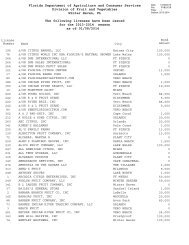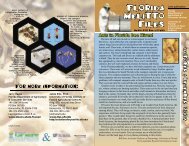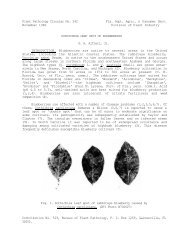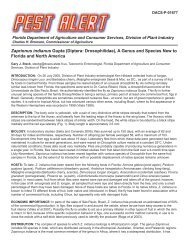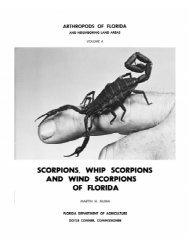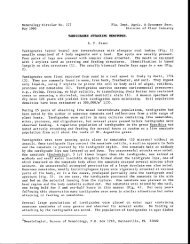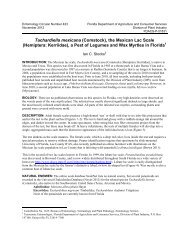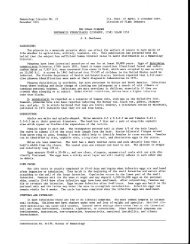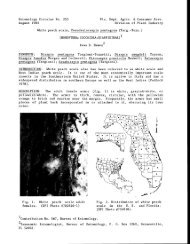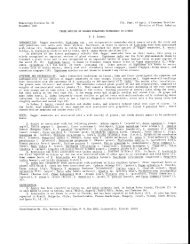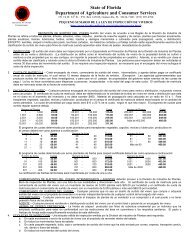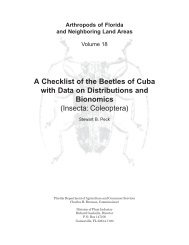Limb Blight Disease Caused by Corticium Salmonicolor B - Florida ...
Limb Blight Disease Caused by Corticium Salmonicolor B - Florida ...
Limb Blight Disease Caused by Corticium Salmonicolor B - Florida ...
Create successful ePaper yourself
Turn your PDF publications into a flip-book with our unique Google optimized e-Paper software.
Plant Pathology Circular No. 71 <strong>Florida</strong> Department of Agriculture<br />
July 1968 Division of Plant Industry<br />
LIMB BLIGHT DISEASE CAUSED BY CORTICIUM SALMONICOLOR B. & BR.<br />
S. A. Alfieri, Jr.<br />
<strong>Corticium</strong> salmonicolor B. & Br. is a basidiomycetous fungus first described<br />
from Ceylon in 1873 <strong>by</strong> Berkeley and Broome (1). Since that time, this same<br />
fungus has been known to have at least five synonyms (5, 6). Edgerton (2) in<br />
1911 presumably made the first report of the occurrence of this fungus in the<br />
United States. It was found on fig, a new host, in Louisiana. Although it has<br />
been reported from the southern tier of states in the United States (6), it<br />
appears to thrive best and occurs with greater frequency in regions of the<br />
tropics and subtropics (A).<br />
Fig. 1. <strong>Limb</strong> blight of Cercis canadensis L. caused <strong>by</strong> <strong>Corticium</strong> salmonicolor B.<br />
& Br. A) The pink mycelial mat of the fungus on the lower side of the<br />
branches, B) enlargement of a portion of “A".
Under warm, moist climatic conditions the pink fungus mat produces great numbers<br />
of spores which appear to be the principal means of dissemination. The spores<br />
are undoubtedly rain-splashed and/or wind-borne to other hosts, thus<br />
establishing new infections.<br />
A number of various disease names have been ascribed to this fungus: pink disease<br />
of rubber, cacao, citrus, oleander, black pepper, tea, and Cinchona; twig blight<br />
of pear; and limb blight of fig and apple (7). A new and unreported host of C.<br />
salmonicolor in <strong>Florida</strong> is redbud, Cercis canadensis L. (3).<br />
SYMPTOMS. Characteristically, the fungus appears as a pink or salmon-colored,<br />
smooth mycelial mat on branches of its hosts, not too distant from the tip.<br />
The fungus mat varies in size from a fraction of an inch to 12 inches or more,<br />
usually established unilaterally on the shaded or lower side of affected<br />
branches such as is shown in Fig. 1. Progressive development of the fungus may<br />
lead to an envelopment of the branch, accompanied <strong>by</strong> a brown discoloration of the<br />
cambial layer, and wilting and dying of the leaves (6).<br />
CONTROL. Since the fungus thrives best under warm, moist conditions, dense or<br />
closely spaced plantings should be avoided. Maintaining plants in a healthy,<br />
vigorous state of growth helps to reduce the incidence of this disease. Infected<br />
branches should be pruned out well below the affected areas and should be<br />
burned or completely eradicated to keep the source of infection at a minimum.<br />
Finally, a fungicide such as a fixed copper or maneb with a spreader-sticker<br />
should be applied to affected plants.<br />
Literature Cited<br />
1. Berkeley, M.J. and C.E. Broome. 1875. Enumeration of the fungi of Ceylon. J.<br />
Linn. Soc. 14(2):29-140.<br />
2. Edgerton, C. W. 1911. Two new fig diseases. Phytopathology 1:12-17.<br />
3. Plant Pathology Section (Records), Division of Plant Industry, <strong>Florida</strong><br />
Dept. of Agr., Gainesville, Fla.<br />
4. Stevens, F.L. 1925. Plant disease fungi. MacMillan Co., New York. 469 p.<br />
5. Talbot, P.H.B. 1965. Studies of Pellicularia and associated genera of<br />
Hymenomycetes. Persoonia 3(4):371-406.<br />
6. Tims, E. C. <strong>Corticium</strong> salmonicolor in the United States. Plant <strong>Disease</strong><br />
Reptr. 47(12):1055-1059.<br />
7. U. S. Department of Agriculture. 1960. Index of plant diseases in the<br />
United States. Agr. Handbook No. 165. 531 p.



